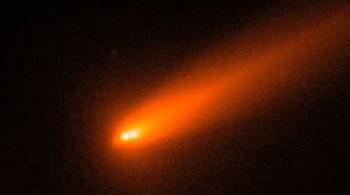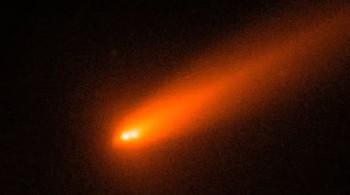
Comet C/2025 K1 (ATLAS) breaks into 3 after coming close to Sun
Comets have long been a source of fascination for astronomers and space enthusiasts alike. These icy bodies from the outer reaches of our solar system offer a glimpse into the early formation and evolution of our cosmic neighborhood. Recently, a remarkable event has unfolded in the skies, as Comet C/2025 K1 (ATLAS) has broken into three pieces after swinging too close to the Sun. This extraordinary occurrence has been captured by astronomers using Italy’s Copernicus telescope, providing a unique insight into the fragile nature of comets.
Comet C/2025 K1 (ATLAS) was first discovered in May 2025 by the Asteroid Terrestrial-impact Last Alert System (ATLAS) survey. Since its discovery, astronomers have been closely monitoring the comet’s trajectory, anticipating its close approach to the Sun. On October 8, the comet made its closest approach to the Sun, known as perihelion, at a distance of approximately 1.2 astronomical units (AU). One astronomical unit is the average distance between the Earth and the Sun, which is about 149.6 million kilometers.
As Comet C/2025 K1 (ATLAS) drew closer to the Sun, the intense heat and radiation from our star began to take its toll on the comet’s fragile nucleus. The nucleus, composed of ice and rocky particles, started to destabilize, ultimately leading to the comet’s breakup. This event was predicted by astronomers, as comets are known to be susceptible to fragmentation when they approach the Sun too closely.
The breakup of Comet C/2025 K1 (ATLAS) was observed by astronomers using the Copernicus telescope in Italy. The stunning images captured by the telescope reveal two large chunks of the comet’s nucleus, which have drifted approximately 2,000 kilometers apart. A smaller, third piece can be seen to the left of the pair, highlighting the violent nature of the comet’s disintegration.
This event provides a unique opportunity for scientists to study the internal structure and composition of comets. By analyzing the fragments of Comet C/2025 K1 (ATLAS), astronomers can gain insights into the comet’s origin and evolution. The breakup of the comet also offers a chance to study the effects of solar radiation on cometary nuclei, which can help scientists better understand the behavior of comets in our solar system.
The observation of Comet C/2025 K1 (ATLAS) also highlights the importance of astronomical surveys and monitoring programs. The ATLAS survey, which discovered the comet, is a robotic astronomical survey system designed to detect near-Earth asteroids and comets. The system’s ability to identify and track comets like C/2025 K1 (ATLAS) allows scientists to predict and prepare for their close approaches to the Sun, enabling a better understanding of these celestial bodies.
As Comet C/2025 K1 (ATLAS) continues on its journey through our solar system, its fragments will likely follow similar orbits, providing astronomers with a unique opportunity to study the comet’s remains. The breakup of the comet serves as a reminder of the dynamic and unpredictable nature of our solar system, where celestial bodies are constantly interacting and evolving.
In conclusion, the breakup of Comet C/2025 K1 (ATLAS) into three pieces after its close approach to the Sun is a remarkable event that offers a unique insight into the fragile nature of comets. The observation of this event by astronomers using the Copernicus telescope highlights the importance of ongoing astronomical surveys and monitoring programs. As scientists continue to study the fragments of Comet C/2025 K1 (ATLAS), they will gain a deeper understanding of the internal structure and composition of comets, as well as the effects of solar radiation on cometary nuclei.





